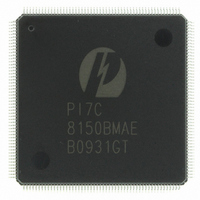PI7C8150BMAE Pericom Semiconductor, PI7C8150BMAE Datasheet - Page 64

PI7C8150BMAE
Manufacturer Part Number
PI7C8150BMAE
Description
IC PCI-PCI BRIDGE ASYNC 208-FQFP
Manufacturer
Pericom Semiconductor
Datasheet
1.PI7C8150BNDE.pdf
(109 pages)
Specifications of PI7C8150BMAE
Applications
*
Interface
*
Voltage - Supply
*
Package / Case
208-FQFP
Mounting Type
Surface Mount
Maximum Operating Temperature
+ 85 C
Minimum Operating Temperature
0 C
Mounting Style
SMD/SMT
Operating Supply Voltage
3 V to 3.6 V
Supply Current (max)
510 mA
Lead Free Status / RoHS Status
Lead free / RoHS Compliant
Available stocks
Company
Part Number
Manufacturer
Quantity
Price
Part Number:
PI7C8150BMAE
Manufacturer:
PERICOM
Quantity:
20 000
8
8.1
8.2
8.2.1
When PI7C8150B receives a target abort or a master abort in response to a locked posted
write transaction, PI7C8150B cannot pass back that status to the initiator. PI7C8150B
asserts SERR_L on the initiator bus when a target abort or a master abort is received during
a locked posted write transaction, if the SERR_L enable bit is set in the command register.
Signal SERR_L is asserted for the master abort condition if the master abort mode bit is set
in the bridge control register (see Section 6.4).
PI7C8150B must arbitrate for use of the primary bus when forwarding upstream
transactions. Also, it must arbitrate for use of the secondary bus when forwarding
downstream transactions. The arbiter for the primary bus resides external to PI7C8150B,
typically on the motherboard. For the secondary PCI bus, PI7C8150B implements an
internal arbiter. This arbiter can be disabled, and an external arbiter can be used instead.
This chapter describes primary and secondary bus arbitration.
PRIMARY PCI BUS ARBITRATION
PI7C8150B implements a request output pin, P_REQ_L, and a grant input pin, P_GNT_L,
for primary PCI bus arbitration. PI7C8150B asserts P_REQ_L when forwarding
transactions upstream; that is, it acts as initiator on the primary PCI bus. As long as at least
one pending transaction resides in the queues in the upstream direction, either posted write
data or delayed transaction requests, PI7C8150B keeps P_REQ_L asserted. However, if a
target retry, target disconnect, or a target abort is received in response to a transaction
initiated by PI7C8150B on the primary PCI bus, PI7C8150B de-asserts P_REQ_L for two
PCI clock cycles.
For all cycles through the bridge, P_REQ_L is not asserted until the transaction request has
been completely queued. When P_GNT_L is asserted LOW by the primary bus arbiter
after PI7C8150B has asserted P_REQ_L, PI7C8150B initiates a transaction on the primary
bus during the next PCI clock cycle. When P_GNT_L is asserted to PI7C8150B when
P_REQ_L is not asserted, PI7C8150B parks P_AD, P_CBE, and P_PAR by driving them
to valid logic levels. When the primary bus is parked at PI7C8150B and PI7C8150B has a
transaction to initiate on the primary bus, PI7C8150B starts the transaction if P_GNT_L
was asserted during the previous cycle.
SECONDARY PCI BUS ARBITRATION
PI7C8150B implements an internal secondary PCI bus arbiter. This arbiter supports eight
external masters on the secondary bus in addition to PI7C8150B. The internal arbiter can
be disabled, and an external arbiter can be used instead for secondary bus arbitration.
SECONDARY BUS ARBITRATION USING THE INTERNAL
ARBITER
To use the internal arbiter, the secondary bus arbiter enable pin, S_CFN_L, must be tied
LOW. PI7C8150B has nine secondary bus request input pins, S_REQ_L[8:0], and has nine
PCI BUS ARBITRATION
Page 64 of 109
ASYNCHRONOUS 2-PORT PCI-TO-PCI BRIDGE
ADVANCE INFORMATION
April 2009 – Revision 1.08
PI7C8150B











